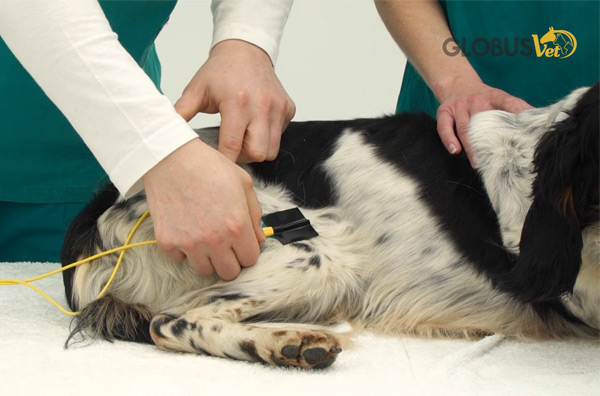
In rehabilitation and veterinary physiotherapy, electric current is used for two fundamental purposes: for the reduction of pain perception and for the stimulation of excitable tissues (muscles).
The analgesic action is promoted by electricity through membrane hyperpolarization using the gate control principle, and by the hyperaemia and the increase of mediators similar to morphine.
ADVANTAGES:
– RAPID PAIN REDUCTION
– PROLONGED ANALGESIC EFFECT
– STIMULATION OF DENERVATED MUSCLES
– FACILITATED FUNCTIONAL RECOVERY
ANTALGIC OR ELECTRO-ANALGESIC ELECTROTHERAPY
NEUROMUSCULAR ELECTROSTIMULATION
(NMES)
TENS is the acronym of Transcutaneos Electrical Nerve Stimulation. This technique, born at the end of the 70s, has represented a remarkable qualitative leap in the field of antalgic therapy.
Analgesic currents are indicated in the symptomatic treatment of peripheral pain.
They are particularly effective in the management of the pain that accompanies most inflammatory processes and osteoarthritis.
ACUTE PAIN
- Post surgical
- Acute traumas
- Inflammatory flares
CHRONIC PAIN
- Osteoarthritis
- Tendinopathy
- Muscular pain
The electric current is able to promote muscular contraction acting on both the motor neuron and the muscle itself. The choice of a stimulation signal must be formulated according to the functional conditions of the muscle (innervated muscle, denervated or partially denervated muscle) and to the objective to pursue. Stimulation electrotherapy is aimed at both normally innervatedmuscles and denervated muscles.
Though not replacing the movement in neuromuscular reactivation, electrotherapy is a useful complement.
In some pathological situations, e.g. peripheral paralysis, electrotherapy is one of the few safeguards that allows to interact with muscle tissue in a way that is different from passive mobilization.
NORMOINNERVATED MUSCLES
- Increased tone and muscular trophism
- Muscle strengthening
DENERVATED MUSCLES
- Acceleration of recovery
- More joint stability
- More range of motion
TENS INDICATIONS
POSTOPERATIVE PAIN FROM ORTHOPEDIC SURGERY
POSTOPERATIVE PAIN FROM SPINAL SURGERY
PAIN FROM OSTEOARTHRITIS
PAIN FROM DISCOPATHY
PAIN FROM LOW BACK STENOSIS
WOBBLER’S SYNDROME PAIN
INCREASE IN THE RANGE OF MOTION
DECREASE IN MUSCLE CONTRACTION
NMES INDICATIONS
ATROPHY/ AMYOTROPHY FROM NEUROLOGICAL DISUSE FIE DA DISUSO NEUROLOGICHE
ATROPHIES/ AMYOTROPHIESFROM ORTHOPEDIC DISUSE
MUSCLE STRENGTHENING FOR POST-OPERATIVE RECOVERY
STIMULATION OF DENERVATED MUSCLE
IMPROVEMENT OF JOINT STABILITY

